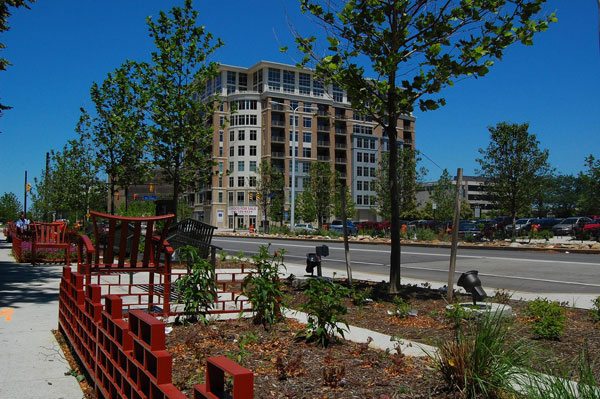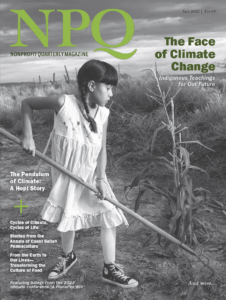
February 14, 2018; Energy News Network and Ohio Citizen Action
In 2009, the city of Cleveland, Ohio, developed a climate action plan called Sustainable Cleveland 2019 in response to rising concerns about climate change. The goal of the 10-year initiative was to create a “Green City on a Blue Lake”—Lake Erie, that is—through plans to prevent, mitigate, and adapt to climate change impacts.
Their plan involves nine action areas identified as vital to creating a “resilient and thriving Cleveland.” Each year was assigned an action area, from Energy Efficiency in 2011 to Engaged People in 2019. These action areas involve everyone in the city, from individual inhabitants, to businesses, to local government. Each contributor brings distinct ways to engage in more sustainable and more equitable behavior. For example, a Climate Action Advisory Committee (CAAC) engaged stakeholders to develop and utilize an equity lens to guide their implementation of the Cleveland Climate Action Plan, an initiative of the 2013 Renewable Energy action area, to make sure the 2013 action plan was effective and equitable.
There’s almost universal agreement that climate change is already happening and its impact hits communities of color at a disproportionately high degree. The communities that are most vulnerable to these impacts are also, sadly, the least culpable. In addition to ample examples of this worldwide, this is evident in Cleveland, where recent studies found urban heat islands concentrated in poor neighborhoods with high amounts of pavement and little tree canopy to provide temperature-lowering cover.
Cleveland has the country’s second-highest big city poverty rate after Detroit, at 35 percent living below the poverty line. Climate advocates and the mayor’s office recognize that a huge percentage of their population is particularly vulnerable to climate change and are therefore developing plans that consider poor communities’ added susceptibility to climate change-related diseases, like asthma.
Advocates have called out four ways to help the city become more resilient to climate change and simultaneously promote social justice: increase access to renewable energy, strengthen communities, make homes more energy-efficient, and plant trees.
Sign up for our free newsletters
Subscribe to NPQ's newsletters to have our top stories delivered directly to your inbox.
By signing up, you agree to our privacy policy and terms of use, and to receive messages from NPQ and our partners.
Planting trees in particular provides ample benefits to city residents. Beyond cleaning the air and providing mental health-boosting green space, trees reduce the heat generated and trapped in densely populated areas. “Heat islands,” where the temperature is higher than in other areas, tend to be populated by lower income people and are characterized by low-rise architecture, lots of paved spaces, and sparse trees. Planting trees in these “ecologically deprived” areas can also promote social equity. Environmental social scientist Juan Declet-Barreto of the Union of Concerned Scientists reported in 2016 that neighborhoods with high percentages of Latinxs and people without a high school diploma were among Cleveland’s hottest areas.
Where trees can mitigate climate change by dispersing heat, home weatherizing serves its dual environmental and equity purposes by saving energy and money. Targeted energy efficiency brings huge savings on utility bills, contributes to grid reliability and energy access, and reduces greenhouse gas emissions from energy generation. A report by the Environmental Defense Fund on the benefits of expanding energy efficiency programs for low-income families indicates that renewable energy should be made more accessible and affordable for vulnerable groups.
The transition to renewable energy cannot leave poor communities behind, reminds NAACP President and CEO Derrick Johnson in his announcement of the organization’s new solar energy initiative. Mike Foley, director of the Department of Sustainability for Cuyahoga County, who sees sustainability as a moral obligation, also adds, “We have to think through how to mitigate and adapt to climate change in a way that recognizes that the personal economics of people play a role in how someone can be green.”
Building resiliency in the face of climate change calls for interventions both technologically complex and simple. Another suggestion is to improve community connections, which leads neighbors to help one another in emergencies like a heat wave. This is part of the Cleveland 2019 action area of engaged people, which identifies a city’s inhabitants as key contributors to change.
Cleveland is among thousands of cities worldwide that are developing their own climate action plans to build resiliency in their own regions, as well as joining collaborations such as the C40 global network of “megacities” or the ICLEI global network of more than 1,500 cities, towns, and regions committed to building a sustainable future. Climate change is real, happening, and unstoppable, so cities must be realistic in preparing for and adapting to climate change impacts, as well as continuing to mitigate and prevent them, especially for their most vulnerable inhabitants.—Mi Lovejoy













